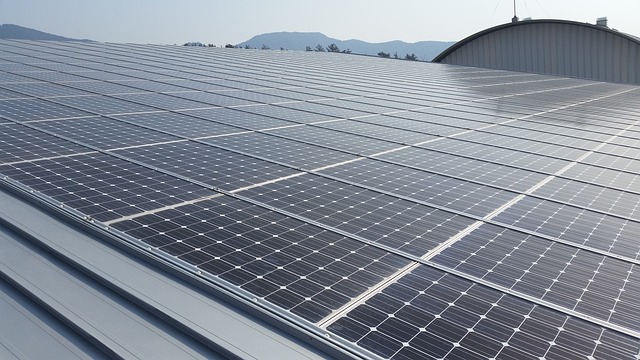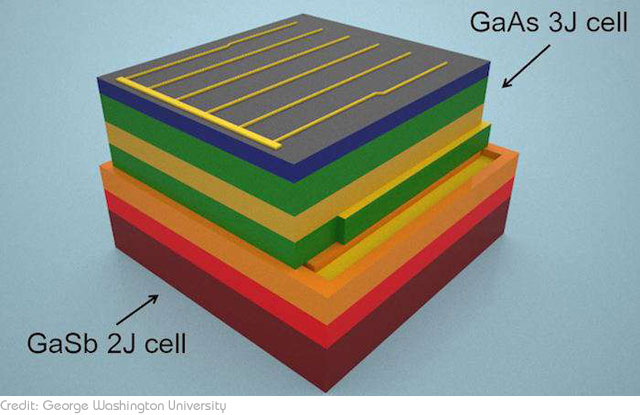
In a paper recently published in the journal Advanced Energy Materials, scientists at the George Washington University (GWU) report that they have developed a new solar cell that is capable of converting direct sunlight into electricity with an efficiency rate of 44.5%. At that rate, it can potentially be the world’s most efficient solar cell ever.
One of the features that differentiate the prototype from typical solar panels installed on rooftops or fields is its use of concentrator photovoltaic (CPV) panels. This type of panel makes use of lenses that concentrate or focus sunlight onto tiny solar cells (less than one millimeter square in size) stacked into one single device that is capable of capturing almost all of the energy available in the solar spectrum.
Another thing going for it is the material it uses. Each layer is made with specialized materials — a family of materials based on gallium antimonide (GaSb) substrates, commonly found in applications for infra-red lasers and photodetectors — this allows the stacked cell to act like a sieve, absorbing the energy of a specific set of wavelengths. By the time the light is directed through the stack, a little below 50% of the absorbed energy has been converted into electricity. Putting that into perspective, the most common solar cells today can only convert about a quarter of available solar energy into electricity.

The most important feature that gives the new design its unprecedented efficiency is its ability to absorb light from wavelengths that aren’t normally absorbed by conventional solar cells. This is made possible by the stacked structure of the cells and the stacking procedure used. The technique is referred to as ‘transfer-printing’ and it is what enables high-precision 3D assembly of the tiny devices. This, in turn, allows the device to capture almost the entire spectral range, from the shorter wavelengths to the longer ones.
As explained by lead author of the study, Matthew Lumb, “about 99% of the power contained in direct sunlight reaching the surface of Earth falls between wavelengths of 250 nm and 2500 nm”. Existing solar cells using conventional materials are not able to capture this kind of spectral range in its entirety.
“Our new device is able to unlock the energy stored in the long-wavelength photons, which are lost in conventional solar cells, and therefore provides a pathway to realizing the ultimate multi-junction solar cell,” Lumb said.
There’s one major downside, though. The new prototype is quite expensive to make. The team acknowledges this and note that while they disregarded cost, their main aim was to show that there are still ways to increase and maximize the efficiency of solar panels. Eventually, it is hoped that the technique they used for this particular solar cell can be refined and streamlined so a cost-efficient and practical product can be made commercially available.
Disclaimer: This page contains affiliate links. If you choose to make a purchase after clicking a link, we may receive a commission at no additional cost to you. Thank you for your support!

Interesting. But at what temperature? Ohms law of electrical resistance states as temperature increases in any material, current flow resistance goes up as well, at least until the plasma state of matter is obtained (Although difficult to contain, as is demonstrated in fusion generators magnetic fields efforts to contain plasma). On the contrary, as temperature decreases so does electrical resistance. Ergo, the need for supercooling till there’s no resistance at all. In any case, most solar cells are most efficient on clear winters day when the temp is about 40′ fahrenheit. At 100′ or more, when solar power is most needed to counter consumption by AC units, most of these systems can only generate 15% of current generated under ideal conditions. To improve conditions for generation, why not simply circulate water underneath any solar cells set. Placed at a shallow enough angle, water circulation might be achieved strictly through the absorption of heat from the solar cells. Through this process, the entire spectrum of suns light can be used to generate energy, not just the current generating spectrum captured by these cells, but the part of the spectrum that generates heat. Come on you engineers, and solar energy installation company reps, can anybody address the ideas I’ve presented. Would like to hear from someone who has experience working with solar power generation.
A few notes: Ohms law does not discuss temperature, that’s a different equation based on resistivity changes due to temperature and some materials actually become less resitive or reluctant as they heat up. Cell efficiency is not significantly changed by temperature but you can easily use active cooling technologies for a relatively inexpensive cost.
The bandgap voltages that convert photons to electrical current are somewhat limited, which is why 45% pev efficiency is considered spectacular. You can get higher efficiency with concentrated solar but you still have to deal with considerable losses, theoretically photoelectric has greater maximum quantum dynamic efficiency.
How does this technique compare to solar heat/steam generating systems like large mirror arrays?
How refreshing,level headed discussion